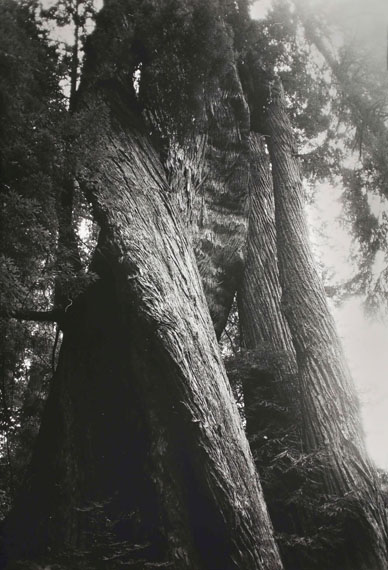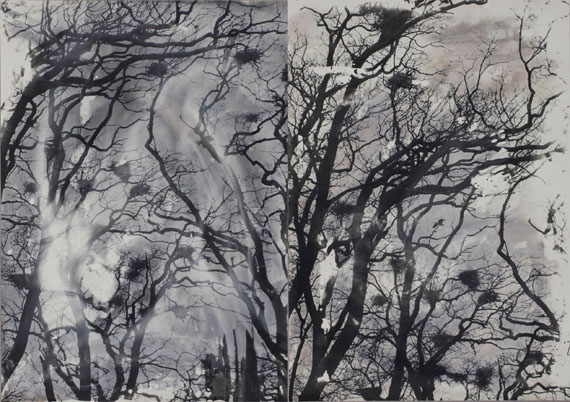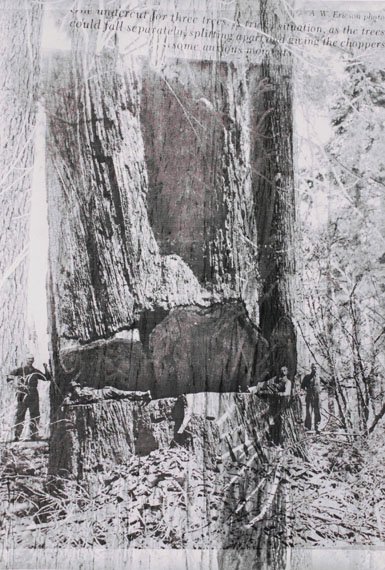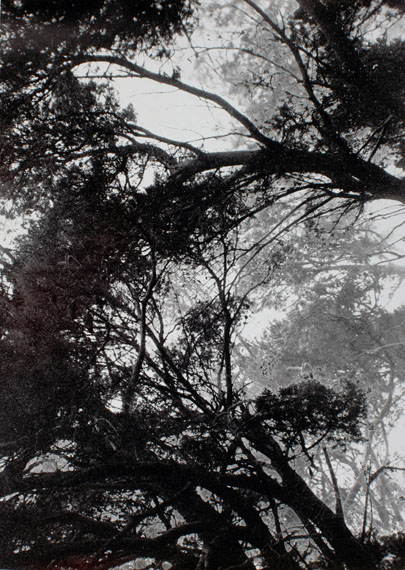
Redwood # 2
2014 Silbergelatine-Barytpapier
© Dörte Eißfeldt
Dörte Eißfeldt »
Wildniß
Exhibition: 19 Sep – 22 Nov 2015
Fri 18 Sep 19:00

Alfred Ehrhardt Stiftung
Auguststr. 75
10117 Berlin
+49 (0)30-20095333
info@aestiftung.de
www.aestiftung.de
Tue-Sun 11-18

Reiherwald (Diptychon)
2012
Silbergelatine-Barytpapier
© Dörte Eißfeldt
Dörte Eißfeldt
"Wildniß"
Exhibition: 19 September until 22 November 2015
Opening: Friday, 18 September 2015 at 7 p.m. The artist will be in attendance.
Wildniß written with an SZ – given the artist’s name, intention is, of course, swiftly suspected. And no sooner has one tripped over this stumbling block than one is thinking about the theme WILDNIS, Wilderness. Today, in the Anthropocene era, the question arises whether a nature untouched by man, a genuine wilderness, even still exists? Or whether all areas of wilderness are not actually anthropogenically influenced cultivated landscapes? According to National Geographic, in 2008 just 17% of the Earth’s ice-free surface area (including the oceans) was without any sign of human activity.
In Dörte Eißfeldt’s series Redwood, Grizzly and Fog Drip the subject is those areas of the United States where redwood trees can still be encountered. The redwood (Sequoiadendron giganteum) can reach a growth height of up to 95 metres, a trunk diameter at the base of up to 17 metres and a weight of 1500 tonnes. Though the coastal redwood (Sequoia sempervirens) is less massive, it can, for all that, grow to 115 metres tall. The oldest living specimens are more than 2500 years old. Redwoods were already in existence 250 million years ago, so long before the dinosaurs became extinct. By the 1960s, within 100 years, around 90% of stocks had been extensively cut down for the construction of houses, railroad sleepers, ship’s planks and mines. Today, just 3% of the original stock of these gigantic trees still exists, and even this stock is not entirely protected.
Dörte Eißfeldt’s works in these series were created in 2013 in the Sierra Nevada as well as in the North Californian Redwood National Parks near the coast on the border with Oregon. Her concern was to capture the particular impression which these "monarchs of the forest"" leave behind in a fitting artistic expression. For she has always dealt with the issue of the image’s qualities. "My aim is to turn the photographic, the medium as process, into an object. I want the photographic image to take a portrait of itself, so to speak.” (Dörte Eißfeldt)
Generally, her work is characterized by the consistent exploration of artistic possibilities of expression and a correspondingly experimental dealing with the medium’s photo-technical and photochemical conditions. Her images, combined by means of montages and multiple exposures into “exposure montages”, refer less to a reality existing outside them than, rather, to their photographic process of becoming. One discerns grey image areas which have arisen through solarization, snuggling into the tree trunks and draping themselves across the branches; traces of the darkroom development on mountain ranges, deposits of metallic silver in the sky and in the form of gold-glistering tones on tree trunks, the results of alchemic processes during developing. A shot from her best-known series Schneeball, where she printed the same negative more than thirty times over in such a richly varied and subtle way that the impression arises that we have various shots here, is also part of the exhibition. Not for nothing did Ute Eskildsen, one of Germany’s greatest photography curators, describe her as a “master of black-and-white photography”. That she is moving forward in analogue photography is evident in the series Grizzly, where she superimposes a digital file which she photographed from books on the subject onto the silver baryta prints of the redwoods.
Naturally, with such a working method, plenty of room is given to chance, and the unforeseen becomes a playful component of the process, bringing about the light-as-a-feather-looking, painterly overall impression. At the same time, the radiographic quality of her black-and-white images becomes a contemporary observation of nature, transposed into the photographic medium.
"To me, photography is working with fragments of reality, experimenting with the material during the photographic analogue or digital process with the aim of producing in the work an independent, intensive and simultaneously open connection to the world; to allow the wild, the dark, the impalpable, the beautiful in the image to remain, or to become, effective, in an open, stimulating, surprising form, very, very large or very, very small" (Dörte Eißfeldt).
�

Grizzly # 2
2014
Pigmentdruck auf Silbergelatine-Barytpapier
© Dörte Eißfeldt
Dörte Eißfeldt
"Wildniß"
Ausstellung: 19. September bis 22. November 2015
Eröffnung: Freitag, 18. September 2015 um 19 Uhr in Anwesenheit der Künstlerin
Wildniß mit SZ geschrieben - mit Blick auf den Namen der Künstlerin vermutet man natürlich schnell Absicht. Und schon ist man über den Stolperstein gepurzelt und denkt über das Thema WILDNIS nach. Heute, im Zeitalter des Anthropozän, stellt sich die Frage, ob es eine vom Menschen unberührte Natur, eine echte Wildnis überhaupt noch gibt? Oder ob nicht alle Wildnisgebiete eigentlich anthropogen beeinflusste Kulturlandschaften sind? Laut National Geographic waren 2008 nur noch 17% der eisfreien Erdoberfläche (inklusive der Meere) ohne Anzeichen menschlichen Tuns.
In Dörte Eißfeldts Serien Redwood, Grizzly und Fog Drip geht es um jene Gebiete der Vereinigten Staaten, in denen Mammutbäume anzutreffen sind. Der Riesenmammutbaum (Sequoiadendron giganteum) kann eine Wuchshöhe von bis zu 95 Meter, einen Stammdurchmesser an der Basis von bis zu 17 Meter und ein Gewicht von 1500 Tonnen erreichen. Der Küstenmammutbaum (Sequoia sempervirens) ist zwar weniger massereich, kann aber dafür bis zu 115 Meter hoch wachsen. Die ältesten lebenden Exemplare sind über 2500 Jahre alt. Mammutbäume existierten bereits vor 250 Millionen Jahren, also lange bevor die Dinosaurier ausgelöscht wurden. Bis zu den 1960er Jahren wurden binnen 100 Jahren rund 90% der Bestände großflächig eingeschlagen für den Bau von Häusern, Eisenbahnschwellen, Schiffsplanken und Bergminen. Heute existieren nur noch 3% vom ursprünglichen Bestand dieser Baum-Giganten, und auch dieser ist nicht in Gänze geschützt.
Dörte Eißfeldts Arbeiten dieser Serien sind 2013 in der Sierra Nevada entstanden sowie in den nordkalifornischen Redwood National Parks nahe der Küste an der Grenze zu Oregon. Dabei ging es ihr darum, den besonderen Eindruck, den diese "Monarchen der Wälder" hinterlassen, in einen adäquaten künstlerischen Ausdruck zu fassen. Denn seit jeher beschäftigt sie sich mit der Frage um die Beschaffenheit des Bildes. "Ich möchte das Fotografische, das Medium als Prozess, zum Gegenstand machen. Das fotografische Bild soll sich sozusagen selbst porträtieren." (Dörte Eißfeldt)
Insgesamt kennzeichnet ihre Arbeit die konsequente Erforschung der künstlerischen Ausdrucksmöglichkeiten und ein entsprechend experimenteller Umgang mit den fototechnischen und fotochemischen Bedingungen des Mediums. Ihre mittels Bildmontagen und Mehrfach-belichtungen zu "Belichtungsmontagen" zusammengefügten Bilder verweisen weniger auf eine außerhalb von ihnen existierende Realität als vielmehr auf ihren fotografischen Werdungsprozess. Man erkennt durch Solarisation entstandene graue Bildflächen, die sich an die Stämme schmiegen und über die Zweige legen, Spuren der Entwicklung auf Gebirgszügen, Ablagerungen von metallischem Silber im Himmel und als goldschillernde Tönungen an Baumstämmen, die durch alchemistische Prozesse beim Entwickeln entstehen. Teil der Ausstellung ist auch eine Aufnahme ihrer bekanntesten Serie Schneeball, bei der sie dasselbe Negativ über dreißigmal so variationsreich und subtil abgezogen hat, dass der Eindruck entsteht, es handele sich um verschiedene Aufnahmen. Ute Eskildsen, eine der größten Fotokuratorinnen Deutschlands, hat sie nicht von ungefähr als "Meisterin der Schwarz-Weiß-Fotografie" bezeichnet. Dass sie nicht bei der analogen Fotografie stehen geblieben ist, zeigt sich in der Serie Grizzly, wo sie über die Silberbarytabzüge der Redwoods eine digitale Datei aufbringt, die sie aus Büchern zum Thema heraus fotografiert hat.
Selbstverständlich ist bei einer solchen Arbeitsweise dem Zufall viel Raum gegeben und wird das Unvorhergesehene spielerischer Bestandteil des Prozesses, der den wie federleicht wirkenden, malerischen Gesamtausdruck bewirkt. Dabei wird die radiographische Qualität ihrer Schwarz-Weiß-Bilder zur zeitgenössischen, ins fotografische Medium übertragenen Naturbeobachtung.
"Fotografie ist für mich das Arbeiten mit Realitätsfragmenten, das Experimentieren mit dem Material im fotografischen analogen bzw. digitalen Prozess mit dem Ziel, in der Arbeit eine eigenständige, intensive und zugleich offene Verbindung zur Welt herzustellen; das Wilde, das Dunkle, das Ungreifbare, das Schöne im Bild wirksam bleiben bzw. werden zu lassen, in einer offenen, anregenden, überraschenden Form, ganz groß oder ganz klein" (Dörte Eißfeldt). �

Capri II # 1
2010
Silbergelatine-Barytpapier
© Dörte Eißfeldt